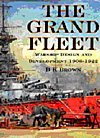 by D. K. Brown, Naval Institute Press, 1999, 208 pp, $59.95 ($47.96 for USNI members)
by D. K. Brown, Naval Institute Press, 1999, 208 pp, $59.95 ($47.96 for USNI members)
The launch of HMS Dreadnought on February 10 th 1906, marked the beginning of a new era in capital ship design, development and construction. Indeed, so significant were the changes that all subsequent all-big-gun capital ships would be known collectively as "Dreadnoughts." The years that followed this historical event would witness some of the most rapid developments in warship design in the 20 th century. To even keep track of the major issues that were under consider-ation would be a monumental task, and yet David K. Brown does exactly that.
To say that Mr. Brown is an accomplished naval architect and a prolific writer would be putting it mildly. He started his career in 1953 and retired 35 years later as the Deputy Chief Naval Architect of the Royal Corps of Naval Constructors. He is currently the Vice President of both the Royal Institute of Naval Architects (RINA) and the World Ship Society. He has authored or edited about a dozen books and over 130 articles and papers. In other words, Mr. Brown knows a lot about warships and how they are put together and fortunately for us, he loves to write about them.
This book, The Grand Fleet, is actually the second in a trilogy on British warship design and development staring with HMS Warrior, the first ironclad, all the way through to HMS Vanguard, the last Royal Navy battleship. In this book, Mr. Brown takes the reader on a personal history tour as he discusses how British warship design was influenced by events the preceded World War I, to the changes demanded by wartime experience. And he doesn't confine his discussion to just battleships and battle cruisers, on the contrary, Mr. Brown deals with all types of warships down to even the lowly mine trawler.
One of the last sections of The Grand Fleet is devoted to what I believe is D.K. Brown's strong suit – battle damage assessment. Here he provides a thorough overview of the effects of naval ordnance on all types of warships, and he specifically addresses the role played by ammunition in the loss of HMS Invincible, Indefatigable, and Queen Mary at the Battle of Jutland. The book then wraps it up with a discussion of the impact of the Washington Naval Treaty on postwar warship designs.
Mr. Brown is one of my favorite naval technical historians. His clear and straightforward writing style, with just an occasional dash of dry British humor, makes the series in general, and this book in particular, easy to read. His approach to discussing the intricacies of naval architecture, a complex subject under the best of circumstances, makes this book enjoyable and understandable to us non-NavArch types. This book is well worth the price and should be seriously considered by World War I naval aficionados.
Other books in the series:
Warrior to Dreadnought: Warship Development 1860-1905, US Naval Institute, 1997
Nelson to Vanguard: Warship Design and Development 1923-1945, US Naval Institute, 2000
BT
Back to The Naval Sitrep #19 Table of Contents
Back to Naval Sitrep List of Issues
Back to MagWeb Master Magazine List
© Copyright 2000 by Larry Bond and Clash of Arms.
This article appears in MagWeb (Magazine Web) on the Internet World Wide Web.
Other military history articles and gaming articles are available at http://www.magweb.com